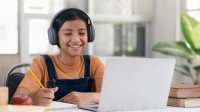5 Keys to Success in Hybrid Learning
Continuing to plan for remote learning is a good way to support students during transitions between distance and hybrid learning.
Your content has been saved!
Go to My Saved Content.Educators have been working hard to ensure that their students are engaged and learning digitally, and they’re facing a flood of emotions while transitioning from remote to hybrid and/or fully in person. They’re excited to see their kids in person (many for the first time) and nervous about what this means for their daily instruction. With students and even teachers oscillating between learning environments, it can be hard to ensure consistency of materials, content, and even agendas while moving to an in-person space where remote learners aren’t able to fully engage.
The best way to support all learners during this time of uncertainty and flux between the remote and in-person worlds is to continue planning for remote learning—because it’s the only way to be consistent, accessible, and nimble enough for the changing tides, while also leveraging all of the skills the students gained in the new self-directed world of learning.
By bringing together the two contexts and continuing to utilize the opportunities that remote learning has to offer—asynchronous learning, self-paced lessons, personalized pathways, additional one-on-one touch points, etc.—we can help students to continue to learn and grow together, as one class, no matter where they are physically.
So how do we build an engaging and equitable simultaneous learning environment? Here are some tips from teachers across the country who continue to innovate and build bridges across the virtual divide.
5 Tips for Engaging and Equitable Hybrid Learning
1. Offer consistent access to routines and resources: Consistent structures, routines, and access to virtual materials allow students to always know where to look when they have to find an assignment, need additional support, or need to find the objective for the day. This can be as simple as sharing an online agenda or, as highlighted by one high school teacher in Milford, Massachusetts, having students work simultaneously using virtual notebooks. When agendas, objectives, assignments, and other materials are in digital formats, routines can stay nimble and consistent, regardless of the learning context.
2. Build a strong, unified culture and community: Opportunities for students to connect with peers in meaningful and collaborative ways, despite their location, are key to building a strong, unified culture—where it’s not an “us and them” mentality between in-person and remote students but instead a “we” dynamic.
By focusing on creating one class, connected virtually through strategic grouping, partnering in-person learners with remote peers, and even implementing remote classroom jobs—for example, students in a Cedar Rapids school can apply to be the greeter, teacher assistant, tech assistant, or chat monitor, regardless of their physical location—educators ensure that all learners are collaborating and connecting as one community.
3. Engage students in multimodal learning: Dynamic daily agendas that allow students to participate using a variety of learning modalities, groupings, and other activities are vital not only for engagement but also for learning. With the focus shifting to in-classroom learning (synchronous and analog), it’s important to remember the other modalities you have at your fingertips (asynchronous and digital), which can be used to build an enriching and exciting daylong or hourlong learning experience where students can engage as a whole group, followed by virtual breakout groups.
For example, remote and in-person students in Norwood, Massachusetts, are given the option of three virtual “Amtrak Learning Cars” (quiet zone, conversation room, and teacher help), independent projects that can extend past the school day, virtual collaboration, and more. When the day and/or hour of instruction are broken up into smaller pieces, students can engage in a variety of ways and also get personalized support when needed.
4. Set up opportunities for self-direction: Simultaneous learning doesn’t have to be purely synchronous and teacher directed. Consider how you can offer choice around your asynchronous and synchronous opportunities throughout your day or class block. Highline Public Schools teachers in Washington have done this by building remote choice boards or playlists, where each student is able to choose the way they learn something, what they learn, or how they show mastery. When interactive activities that allow agency and choice are built in, students are able to take ownership of their learning and go deeper into content while also using the self-direction skills they developed during remote learning.
5. Design remote-friendly assessment: In order to get the pulse of where students are daily and weekly, it’s important to build remote-friendly assessments so that you can assess both in-person and remote learners simultaneously and equitably.
For example, try to design assessments that are not only accessible but engaging, like a strategy used by an Intrinsic Schools teacher in Chicago called “Wait Questions”: She asks students to answer a question in chat and tells them not to press enter until she says “Go.” Then, once the chat is flooded with answers, the students do a gallery walk of all the answers while the teacher scans for where the class or individual students may need clarification or additional help.
By assessing students often in formal and informal remote-friendly ways, educators can build a stronger picture of each student’s learning and mastery, as well as when additional support is needed.
As the school year comes to an end and educators continue to teach remotely or in a hybrid limbo, it’s important to keep planning instruction that’s both consistent and accessible for all learners, despite their physical location. The strategies above, along with others shared by educators across the country, offer concrete ways to implement effective instruction and ensure equitable education for your students both now and in the future—whatever that looks like in the fall.
